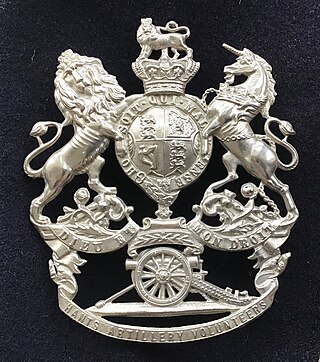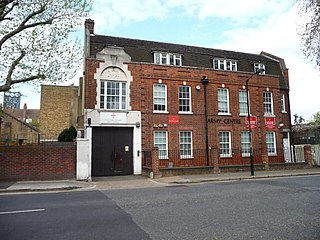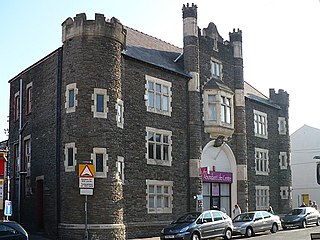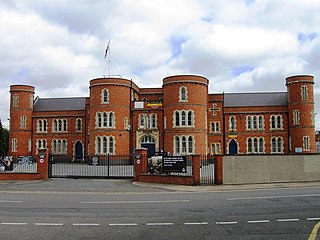
The Post Office Rifles was a unit of the British Army, first formed in 1868 from volunteers as part of the Volunteer Force, which later became the Territorial Force. The unit evolved several times until 1921, after which the name was lost during one of many reorganisations.
The Volunteer Force was a citizen army of part-time rifle, artillery and engineer corps, created as a popular movement throughout the British Empire in 1859. Originally highly autonomous, the units of volunteers became increasingly integrated with the British Army after the Childers Reforms in 1881, before forming part of the Territorial Force in 1908. Most of the regiments of the present Army Reserves Infantry, Artillery, Engineers and Signals units are directly descended from Volunteer Force units.
The 1st Isle of Wight Rifle Volunteers, later the 8th Battalion, Hampshire Regiment, but known informally as the 'Isle of Wight Rifles', was an auxiliary unit of the British Army formed to defend the Isle of Wight after a mid-19th Century invasion scare. During World War I it fought in the Gallipoli Campaign, taking part in the calamitous attack at Suvla Bay, and later at the battles of Gaza and Megiddo in Palestine. Between the wars it was converted to coast defence artillery and served in this role on the Isle of Wight throughout World War II. One battery was sent to reinforce the garrison of Tobruk, where it was captured in 1942. Postwar the unit converted to the air defence role, then reverted to infantry, and its successors continue in today's Army Reserve.

The 1st Wessex Artillery was a volunteer unit of the British Army that existed under various titles from 1860 to 1971, including active service in Mesopotamia in World War I and North Africa and Italy in World War II.
The Hampshire Brigade, previously the Portsmouth Brigade and later 128th (Hampshire) Brigade, was an infantry formation of the British Army of the Volunteer Force, Territorial Force (TF) and Territorial Army (TA) in existence from 1889 until after the Second World War. It served in British India during the First World War, but not as a complete formation. During the Second World War, the 128th Infantry Brigade fought in the Tunisia Campaign, in the Italian Campaign, and later in the Greek Civil War. The brigade was composed entirely of battalions from the Hampshire Regiment.

The Braganza Street drill hall is a military installation in Braganza Street, Walworth.

The West Princes Street drill hall is a former military installation in Glasgow, Scotland.

The Mitcham Road Barracks is an Army Reserve centre in Croydon, London, with a history dating back to 1794.

Dare Wilson Barracks, is a military installation in Hexham, Northumberland. The building is named after Major General Dare Wilson who was commissioned into the Royal Northumberland Fusiliers and commanded 22 Special Air Service Regiment in the early 1960s.

Stockport Armoury is a military installation in Stockport, Greater Manchester, England. It is a Grade II listed building.

The Lower Dock Street Street drill hall is a former military installation in Newport, Wales.

The Stanhope Road drill hall, sometimes known as the Connaught Drill Hall, is a former military installation in Portsmouth, Hampshire. It is a Grade II listed building.

The Clare Street drill hall is a military installation in Northampton, Northamptonshire. It is a Grade II listed building.

The 6th Battalion, Hampshire Regiment was an infantry battalion of the British Army. Part of the Volunteer Force, later the Territorial Force, the battalion was part of the Hampshire Regiment and recruited from Portsmouth, Hampshire. It served as infantry during World War I and as a Royal Artillery regiment during and after World War II.

The Exeter & South Devon Volunteers was the premier unit of Britain's Volunteer Force. Formed in 1852 it went on to become a battalion of the Devonshire Regiment. Both its active service battalions went to garrison India on the outbreak of the First World War, and then saw action in Mesopotamia and Palestine. In the Second World War, the battalion served in the garrison of Gibraltar. It continued in the postwar Territorial Army until it was merged with other West Country units. Its successors today serve in a reserve battalion of The Rifles.
The 7th Battalion, The Rifles is an Army Reserve battalion of the British Army originally formed in 1999 as an independent regiment, however later became part of The Rifles following the Future Army Structure programme, and remains an integral part of the regiment.












